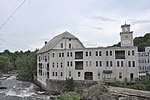Hillsborough, New Hampshire
Hillsborough, New HampshirePopulated places established in 1772Towns in Hillsborough County, New HampshireTowns in New HampshireUse mdy dates from May 2015

Hillsborough, frequently spelled Hillsboro, is a town in Hillsborough County, New Hampshire, United States. The population was 5,939 at the 2020 census. The town is home to Fox State Forest and part of Low State Forest. The main village of the town, where 2,156 people resided at the 2020 census, is defined as the Hillsborough census-designated place (CDP), and is located along the Contoocook River at the junction of New Hampshire Route 149 with Henniker Street and Main Street. The town also includes the villages of Hillsborough Center, Hillsborough Upper Village, Hillsborough Lower Village, and Emerald Lake Village.
Excerpt from the Wikipedia article Hillsborough, New Hampshire (License: CC BY-SA 3.0, Authors, Images).Hillsborough, New Hampshire
Geographical coordinates (GPS) Address Nearby Places Show on map
Geographical coordinates (GPS)
| Latitude | Longitude |
|---|---|
| N 43.114722222222 ° | E -71.895 ° |
Address
03244
New Hampshire, United States
Open on Google Maps







